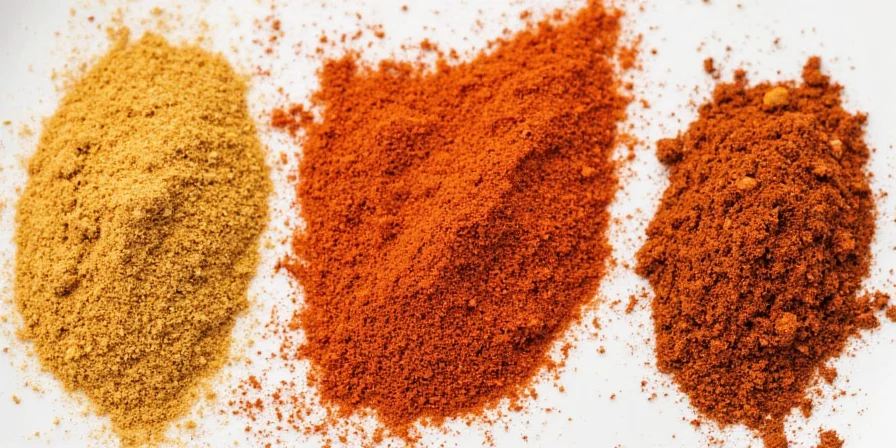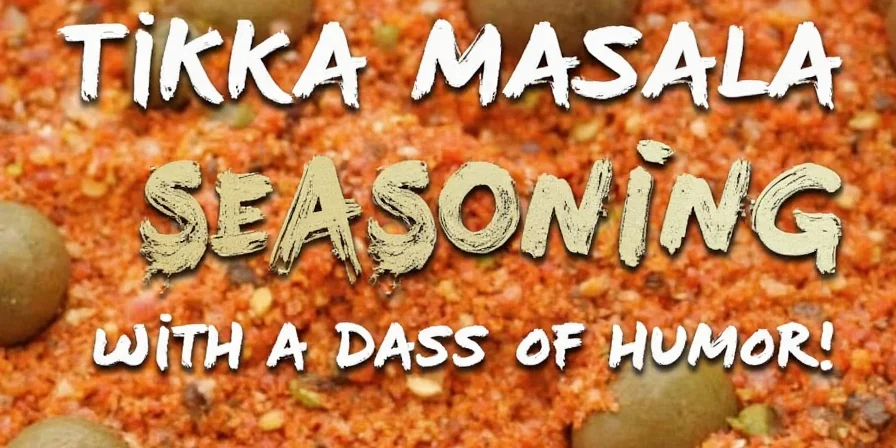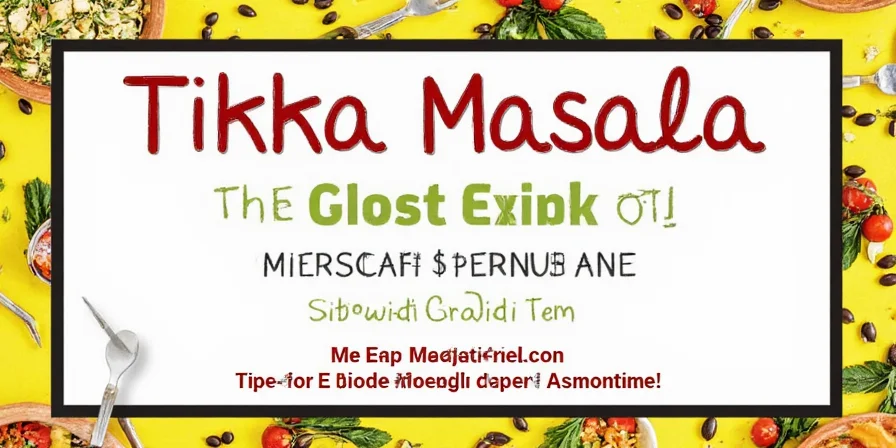Table of Contents
- Introduction
- The Complex Origin Story
- Spice Chemistry: What Makes Tikka Masala Seasoning Work
- 5 Scientifically-Optimized Usage Techniques
- Cross-Cultural Spice Traditions: A Comparative Analysis
- Spice Blend Characteristics Compared
- Advanced Flavor Development Strategies
- Conclusion
Understanding Flavor Engineering Through Tikka Masala
When experiencing chicken tikka masala, you're encountering a sophisticated flavor system where volatile compounds interact with your sensory receptors. This article examines the science behind tikka masala seasoning, moving beyond basic recipes to explore the biochemical interactions that create its distinctive profile.

Unlike superficial spice guides, this analysis focuses on how specific compounds in each ingredient interact with fats, acids, and proteins to create complex flavor development over time. We'll explore practical applications grounded in food chemistry principles.
Historical Context and Culinary Evolution
While popular narrative credits Glasgow in the 1970s with tikka masala's creation, food historians note that tomato-based curry preparations appear in Mughlai cuisine records from the 16th century. The modern commercial seasoning blend emerged as a standardized product in the 1980s to meet growing global demand.

Regional variations across India demonstrate how local agricultural conditions shaped distinct spice ratios. In Punjab, higher dairy content balances the heat, while coastal regions incorporate more black pepper and coconut.
Chemical Composition and Flavor Activation
Tikka masala seasoning's effectiveness depends on understanding how specific compounds interact:
- Cumin's cuminaldehyde requires fat for optimal release
- Coriander's linalool compounds degrade rapidly when exposed to air
- Turmeric's curcumin becomes bioavailable when combined with piperine from black pepper
- Paprika's capsanthin needs controlled heat (140-160°F) to release maximum color
- Garam masala's eugenol compounds benefit from gradual temperature increase
- Garlic's allicin forms only when crushed and allowed to rest
- Ginger's zingerone develops through controlled heating
- Cayenne's capsaicin binds with fats for sustained heat delivery

Commercial blends often add dried fenugreek leaves (methi) for sotolon compounds that create maple-like undertones, enhancing the overall flavor complexity.
Scientifically-Validated Application Methods
Optimize your culinary results by understanding how to maximize flavor compound extraction:
- Controlled Blooming: Heat spices in oil at precise temperatures (325°F) to extract volatile compounds without burning.
- Rice Enhancement: Add seasoning during the absorption phase, not after cooking, to allow compounds to penetrate starch granules.
- Vegetable Synergy: Roast vegetables at 400°F with seasoning to trigger Maillard reactions that complement spice compounds.
- Emulsion Development: Create stable spice-infused mayonnaise by gradually incorporating oil to encapsulate hydrophobic compounds.
- Temperature-Modulated Heat: Layer cayenne at different cooking stages to create progressive heat release rather than single-peak intensity.

Cross-Cultural Flavor System Comparisons
Different culinary traditions solve similar flavor challenges through distinct biochemical approaches. This comparative analysis reveals underlying principles:
| Culinary Tradition | Primary Flavor Compounds | Delivery Mechanism | Heat Management Strategy |
|---|---|---|---|
| Indian (Tikka Masala) | Curcumin, capsaicin, eugenol | Fat-based extraction | Layered thermal application |
| Middle Eastern (Za'atar) | Thymol, carvacrol, sesamin | Dry application with oil | Room-temperature infusion |
| Mexican (Adobo) | Vanillin, capsaicin, thymol | Vinegar-based extraction | Acid-modulated heat |
| East Asian (Five-Spice) | Anethole, eugenol, limonene | Steam-based infusion | Sequential spice addition |
| Mediterranean (Herbes de Provence) | Linalool, rosmarinic acid | Slow oil diffusion | Low-temperature integration |
Spice Blend Characteristics Compared
Understanding the chemical composition helps determine appropriate applications:
| Characteristic | Tikka Masala | Standard Curry Powder | Regional Variations |
|---|---|---|---|
| Primary Volatile Compounds | Curcumin, piperine | Curcumin, cinnamaldehyde | Punjab: Higher dairy compounds South India: More mustard oil compounds |
| Optimal Temperature Range | 325-375°F | 275-325°F | Coastal: 300-350°F Inland: 350-400°F |
| Fat Solubility | High (requires fat for full extraction) | Moderate | Punjab: Higher fat solubility Kashmir: Balanced solubility |
| Acid Stability | Moderate (degrades above pH 4.5) | Low (degrades above pH 5.0) | Gujarat: Higher acid tolerance Bengal: Lower acid tolerance |
| Shelf Life (optimal) | 6 months (light-sensitive compounds) | 12 months | Dry regions: 8 months Humid regions: 4 months |

Advanced Flavor Development Techniques
Professional results require understanding biochemical interactions:
- Compound Activation: Toast whole spices to 350°F to convert precursors into active flavor compounds before grinding
- Sequential Bloom: Add spices in temperature-specific stages to maximize different compound extractions
- Acid Timing: Introduce acidic components after primary spice blooming to preserve volatile compounds
- Salt Interaction: Use salt early to modify protein structures for better spice absorption
- Resting Periods: Allow 12-24 hours for complete flavor integration as compounds migrate through food matrices
Conclusion: The Science Behind Flavor Mastery
Tikka masala seasoning represents a sophisticated flavor system where biochemical interactions create complex sensory experiences. Understanding the science behind spice compounds and their interactions allows for precise flavor engineering rather than random experimentation.
By applying these principles, home cooks can achieve professional-level results through controlled application of temperature, fat, acid, and timing. The true power of this spice blend lies not in its ingredients alone, but in how they work together through scientifically predictable interactions.
Frequently Asked Questions
How does heat affect tikka masala seasoning compounds?
Different compounds respond uniquely to heat. Curcumin (from turmeric) degrades above 375°F, while capsaicin (from cayenne) remains stable up to 400°F. Optimal blooming occurs between 325-350°F, allowing maximum compound extraction without degradation. Lower temperatures (250-300°F) better preserve volatile compounds like linalool from coriander.
Why does tikka masala seasoning need fat for optimal flavor?
Many key compounds in tikka masala seasoning are hydrophobic, including curcumin and eugenol. Fat molecules act as carriers that transport these compounds across taste receptors. Without sufficient fat, up to 70% of flavor compounds remain unextracted, resulting in significantly muted flavor profiles.
What's the optimal storage method for tikka masala seasoning?
Store in an airtight container away from light and moisture at temperatures below 70°F. Exposure to light degrades curcumin compounds within weeks. For maximum shelf life, divide into small portions and freeze the majority, only thawing what you'll use within 30 days. Ground spices lose 30-50% of volatile compounds within 6 months under standard storage.
How does tikka masala seasoning differ from standard curry powder?
Tikka masala seasoning contains higher concentrations of tomato-compatible compounds and is formulated specifically for cream-based sauces. It typically includes more paprika for color stability in dairy environments and less turmeric than standard curry powder. The heat profile is designed for gradual release rather than immediate intensity.
Can I make tikka masala seasoning without cayenne pepper?
Yes, but you'll need to adjust other heat components. Black pepper provides different heat compounds (piperine) that create slower-building warmth. Kashmiri chili powder offers color without intense heat. For authentic flavor progression, combine small amounts of multiple heat sources rather than relying on a single ingredient.











 浙公网安备
33010002000092号
浙公网安备
33010002000092号 浙B2-20120091-4
浙B2-20120091-4